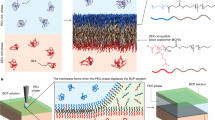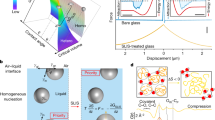Abstract
LIQUID organic solvents have been used to simulate biological membranes by making the organic solvent act as a bridge between two aqueous pools. The transport of ions (both K+ and Na+) from one pool to another across such oil membranes has been studied1–3. We report here a number of very interesting and perhaps useful features in the application of such membranes.
This is a preview of subscription content, access via your institution
Access options
Subscribe to this journal
Receive 51 print issues and online access
$199.00 per year
only $3.90 per issue
Buy this article
- Purchase on SpringerLink
- Instant access to full article PDF
Prices may be subject to local taxes which are calculated during checkout
Similar content being viewed by others
References
Osterhout, W. J. V., Ergebn. Physiol., 35, 965 (1933).
Rosano, H. L., Schulman, J. H., and Weisbuch, J. B., Ann. NY Acad. Sci., 92, 457 (1961).
Schulman, J. H., and Rosano, H. L., Retardation Evaporation Monolayers, Pap., Symp. New York, NY, 97 (1962).
Author information
Authors and Affiliations
Rights and permissions
About this article
Cite this article
MOORE, J., SCHECHTER, R. Transfer of Ions against their Chemical Potential Gradient through Oil Membranes. Nature 222, 476–477 (1969). https://doi.org/10.1038/222476b0
Received:
Issue date:
DOI: https://doi.org/10.1038/222476b0



